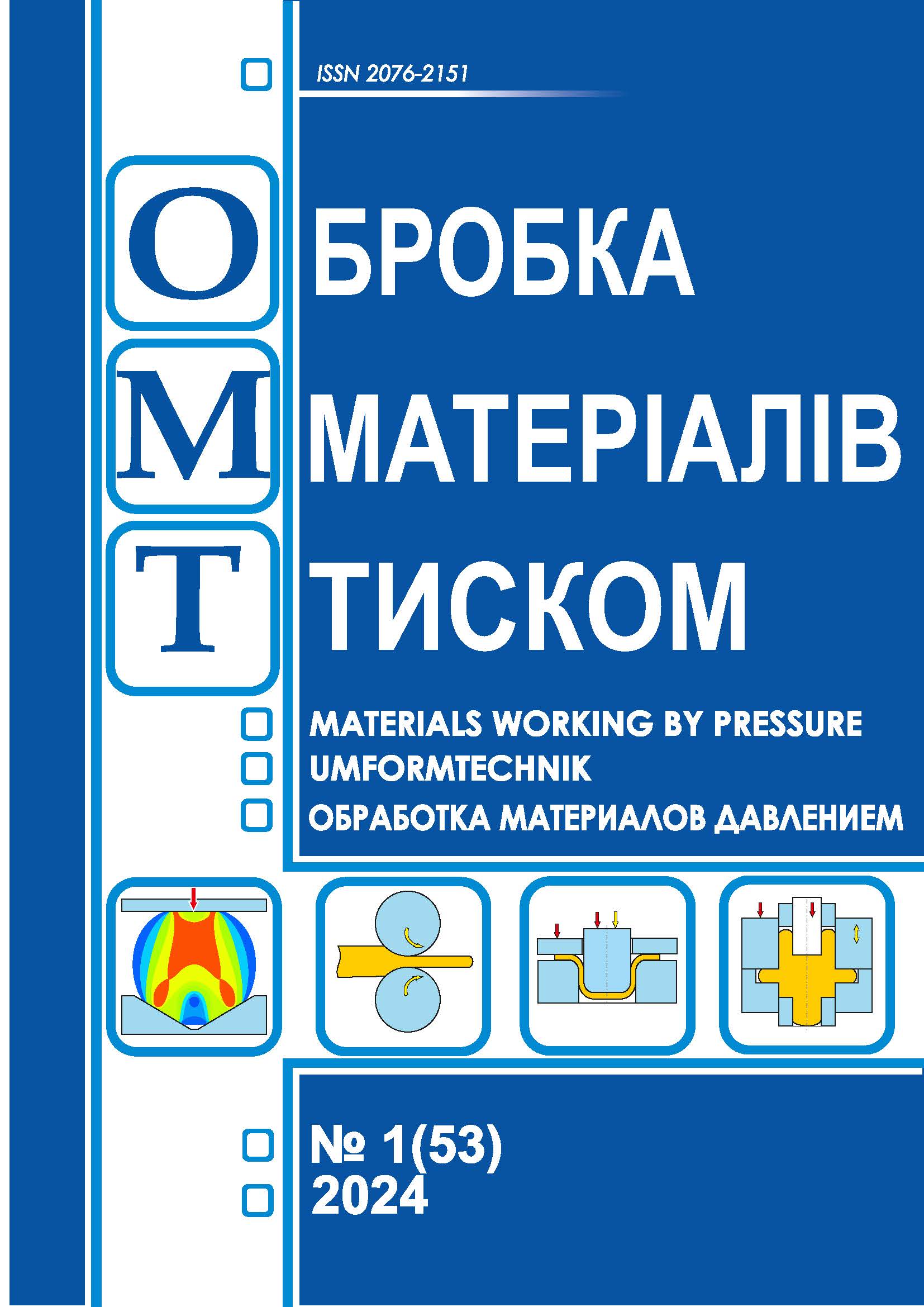Study of the mechanism of magnetostrictive and magnetodispersive hardening of punches made of high-speed steel after processing in pulsed magnetic fields
DOI:
https://doi.org/10.37142/2076-2151/2024-(53)181Keywords:
piercing punch, pulsed magnetic field, magnetostrictive hardening, stability, hardening, heat resistance, high-speed steel.Abstract
Kindenko М.
Study of the mechanism of magnetostrictive and magnetodispersive hardening of punches made of high-speed steel after processing in pulsed magnetic fields
The presented work is devoted to the study of issues related to the study of the mechanisms of magnetostriction and magnetic dispersion hardening of the working part of punches made of high-speed steel P6M5 and P6M5K5 for stability after magnetic pulse processing, which is a combination of electromagnetic and thermodynamic methods of controlling the non-equilibrium structure substances. High-speed steel, like any solid body, has an elastic internal field due to the real dislocation structure. When a magnetic field is applied to a material, an elastic field caused by magnetostrictive deformation is superimposed on this own elastic field. In general, the result of magnetic processing is considered as a manifestation of aftereffects in materials that are at the boundaries of the stability of their properties and are exposed to the action of an external force field. It was noted that as a result of the pulsed magnetic field, the physical and mechanical properties of high-speed steel change and the tool material becomes more uniform in structure. Applying magnetic processing, it is possible to significantly reduce the excessive energy of the material associated with the concentration of internal and surface stresses in the tool, and reduce the probability of its breakage to a minimum. Magnetic pulse processing is a complex effect on the material of magnetostrictive processes and mechanical deformations, thermal and electromagnetic eddy currents localized in places of magnetic flux concentrations. It is shown that as a result of magnetic treatment, high-speed steel undergoes volume strengthening, dispersion hardening, becomes more homogeneous in structure and improves its physical and mechanical properties. The pulsed magnetic field, interacting with the material of the tool, changes its thermal and electromagnetic properties, improves the structure and operational characteristics, which is the basis of the magnetic strengthening technology. It was established that the root cause of the improvement of the operational characteristics of the tool subjected to magnetic treatment is the change in the properties of the tool material. This happens due to the magnetostrictive strengthening of high-speed steel, which is expressed in an increase in its heat resistance.
References
Aliieva L.I., Tahan L.V. Resource-saving processes of cold treatment: a guide for students. Kramatorsk: DSEA. 2020. 180 p. ISBN 978-966-379-927-8. (in Ukrainian).
Preobrazhensky A. A. Theory of magnetism, magnetic materials and elements. Moscow: Higher school. 1972. 460 p. (in Russian).
Winter E. K. Magnetic resonance in metals. Moscow: Mir. 1976. 486 p. (in Russian).
Malygin B. V. Magnetic hardening of the tool and machine parts. Moscow: Mechanical engineering. 1989. 112 p. (in Russian).
Ovcharenko A.G., Kozlyuk A.Y. Effective magnetic-pulse processing of cutting tools. Metal processing. 2009. № 1. рp. 4–7. (in Russian).
Volodin V. L., Zuev L. B., Volodin T. V., Gaiduk V. V. Investigation of the influence of magnetic-pulse surface impacts on the performance characteristics of tool steels and tools. Izvestia of higher educational institutions. Ferrous metallurgy. Moscow: 2009. № 6.pp. 61–65. (in Russian).
Bershtein M. L., Pustovoit V. N. Heat treatment of steel products in a magnetic field. Moscow: Mechanical engineering. 1987. 256 p. (in Russian).
Kindenko N. I. Analysis of Hypotheses on the Causes of Increasing the Tool Life of High-Speed Steel as a Result of the Influence of a Magnetic Field. Visnik Donbass State Engineering Academy. Kramatorsk: DSEA. 2019. № 2 (46). рp. 83–88. (in Russian).
Kindenko M.I. Analysis of methods of magnetic processing of trimming matrices for cold and volume stamping of bolts and nuts. Collection of scientific papers of Dnepropetrovsk State Technical University (technical sciences). Kamianske. DGTU. 2020. – Volume 1. № 36. рp. 58–62. (in Ukrainian).
Alifanov A.V., Maleronok V.V., Bogdanovich I.A., Lyakh A.A., Milyukova A.M., Tolkacheva O.A. trans-formations in the surface layers of samples from high-speed steel. Bulletin of Polotsk State University. Series B. In-dustry. Applied Science. Novopolotsk: 2021. (3). pp. 11–14. (in Russian).
Alifanov A.V., Tsionenko D.A., Milyukova A.M., Tsionenko N.M. Magnetostrictive mechanism of finely dispersed structure formation in steel products under magnetic-pulse exposure. News of the National Academy of Sciences of Belarus. Sеr. fiz.-mat. navuk. 2016. № 4. рp. 31–36. (in Russian).
Batygin Yu.V., Lavinsky V.I., Khimenko L.T. Pulsed Magnetic Fields for Progressive Technologies. Kharkiv: MOST-Tornado. 2003. 288 p. (in Russian).
Batygin Yu.V., Lavinskiy V.I., Khimenko L.T. Physical Foundations of Possible Directions for the Devel-opment of Magnetic-Pulse Processing of Thin-Walled Metals. Electrotechnics and Electrical Mechanics. 2004. № 2. рp. 80–84. (in Russian).

